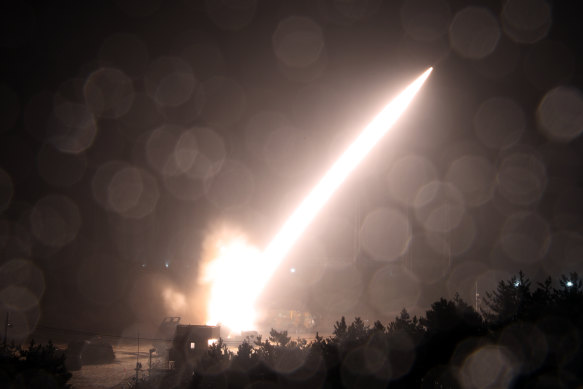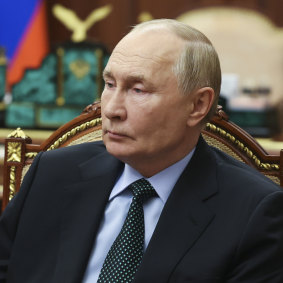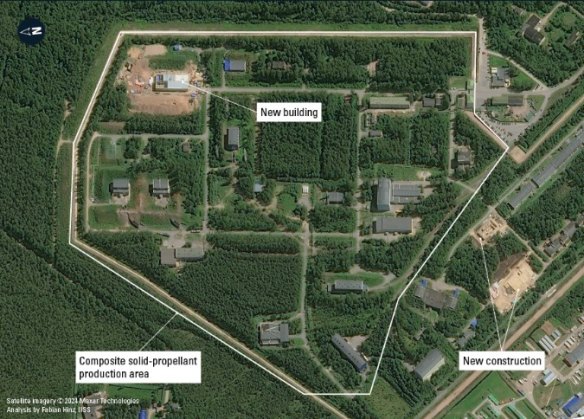‘Fuel to the fire’: Moscow warns the US over allowing Ukraine to strike deeper into Russia
By Samya Kullab and Illia Novikov
Kyiv: The Kremlin warned that President Joe Biden’s decision to let Ukraine strike targets inside Russia with US-supplied longer-range missiles adds “fuel to the fire” of the war and would escalate international tensions even higher.
Biden’s shift in policy added an uncertain, new factor to the conflict on the eve of the 1000-day milestone since Russia began its full-scale invasion in 2022.

An ATACMS in use in South Korea.Credit: Getty
It also came as a Russian ballistic missile with cluster munitions struck a residential area of Sumy in northern Ukraine, killing 11 people, including two children, and injuring 84 others. Another missile barrage sparked apartment fires in the southern port of Odesa, killing at least 10 people and injuring 43, including a child, Ukraine’s Interior Ministry said.
Washington is easing limits on what Ukraine can strike with its American-made Army Tactical Missile System or ATACMs, US officials told the Associated Press on Sunday, after months of ruling out such a move over fears of escalating the conflict and bringing about a direct confrontation between Russia and NATO.
The Kremlin was swift in its condemnation.
“It is obvious that the outgoing administration in Washington intends to take steps and they have been talking about this, to continue adding fuel to the fire and provoking further escalation of tensions around this conflict,” spokesman Dmitry Peskov told reporters.

Emergency services personnel work to extinguish a fire following a Russian rocket attack in Poltava region Ukraine.Credit: AP
The scope of the new firing guidelines isn’t clear. But the change came after the US, South Korea, and NATO said recently that North Korean troops are in Russia and apparently are being deployed to help Moscow drive Ukrainian troops out of Russia’s Kursk border region.
Biden’s decision was almost entirely triggered by the entry of North Korea into the fight, according to a US official who spoke on condition of anonymity to discuss internal deliberations.
Russia also is slowly pushing Ukraine’s outnumbered army backward in the eastern Donetsk region. It has also conducted a devastating aerial campaign against civilian areas in Ukraine.
Missile production
Satellite images show major expansions at five complexes where Russia has made solid-fuel missile engines, indicating the Kremlin plans to significantly boost missile production as it pursues its war in Ukraine, according to a European researcher.

Putin listens to head of Russian-controlled Zaporizhzhia region of Ukraine, Yevgeny Balitsky during their meeting at the Kremlin.Credit: AP
Fabian Hinz, a Berlin-based researcher at the International Institute for Strategic Studies (IISS), a global security think tank, identified the complexes using Russian media reports and declassified Cold War-era CIA documents that listed facilities where the Soviet Union produced solid-fuel missile engines.
The sites are in the Altai Republic in Siberia, Rostov in southern Russia, outside Moscow and St. Petersburg, and in Perm, in western Russia. Satellite photos taken by Maxar Technologies in July, September and October, reviewed by Reuters, show cleared vegetation and extensive new construction next to buildings that Hinz identified as solid-fuel research and production facilities at the five complexes.
Following the invasion of Ukraine in 2022, Russian President Vladimir Putin has ordered increased funding to expand defence production. “Satellite imagery suggests that solid-propellant rocket motor-production capacity appears to be one focus of this effort,” Hinz wrote in his report, which was published in Military Balance Plus, an IISS blog.
In another troubling sign, on Monday, Helsinki-time, two undersea fibre-optic communications cables in the Baltic Sea, including one linking Finland and Germany, were severed, raising suspicions of sabotage by bad actors, countries and companies involved said.
Finland and Germany said in a joint statement that they were “deeply concerned about the severed undersea cable” and were investigating “an incident (that) immediately raises suspicions of intentional damage.”
Europe’s security is threatened by Russia’s war against Ukraine and “hybrid warfare by malicious actors,” the joint statement said, without naming the actors.
Earlier, Estonian Foreign Minister Margus Tsahkna said on Monday that German Chancellor Olaf Scholz’s call with Putin on Friday was a “strategic mistake” that had weakened European unity in the face of Moscow’s war against Ukraine.

Shlisselburg solid-propellant motor production site, Russia.Credit: Maxar, IISS
Scholz held a one-hour call with Putin last week, his first direct communication with Russia’s leader in almost two years. He defended the call as a way to make clear to Putin that German, European and other support for Ukraine would not wane.
But Tsahkna, whose Baltic nation is one of Ukraine’s most vocal supporters and one of Moscow’s fiercest critics, said the call had damaged Western efforts to isolate Putin.
“It was a strategic mistake,” he said. “We have had a principle agreed that we keep Putin in isolation.”
“It just weakened our unity and our positions,” Tsahkna said.
AP, Reuters
Get a note directly from our foreign correspondents on what’s making headlines around the world. Sign up for the weekly What in the World newsletter here.